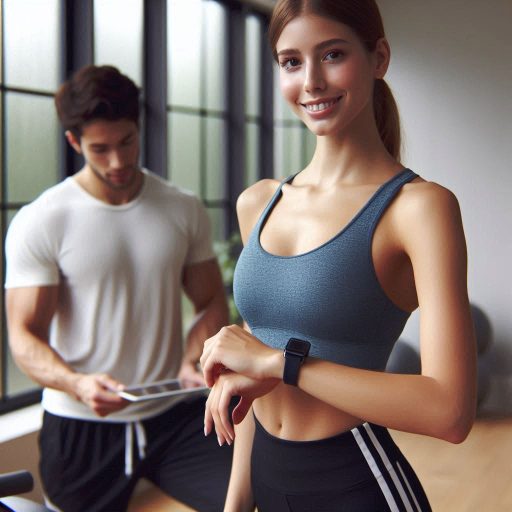Introduction
Personal training apps and tools have transformed the fitness landscape.
They provide users with convenience, accessibility, and personalized workout experiences.
Many individuals find it challenging to stay motivated and reach their fitness goals.
Personal training apps address this issue by offering guidance, structure, and accountability.
The trend of integrating technology into fitness continues to grow.
More people use apps to track their workouts, monitor nutrition, and set health goals.
This shift makes fitness more accessible to everyone, regardless of experience level.
With the right tools, users can design tailored workout plans that fit their schedules.
In 2024, several top personal training apps stand out in the crowded market.
These apps not only offer workout routines but also provide nutritional advice, progress tracking, and community support.
They cater to various fitness levels and preferences, from strength training to yoga.
As fitness enthusiasts increasingly embrace technology, personal training apps play a crucial role.
They empower users to take charge of their fitness journeys.
In this blog post, we will explore the top personal training apps and tools for 2024.
Discover how these innovative solutions can help you achieve your health and fitness goals more effectively.
Features and functionalities of the top personal training apps
When it comes to personal training apps, there are a variety of features that set the best ones apart from the rest.
These features are designed to make it easier for users to track their progress, set goals, and stay motivated on their fitness journey.
Let’s take a look at some of the key features offered by leading personal training apps:
Workout tracking
- Allows users to log their exercises, sets, reps, and weights for each workout session.
- Provides a comprehensive view of progress over time, making it easier to identify areas for improvement.
- Enables users to easily track their performance and stay accountable to their fitness goals.
Customizable workout plans
- Offers personalized workout routines based on individual goals, fitness level, and preferences.
- Allows users to choose from a variety of workout types, including strength training, cardio, and flexibility exercises.
- Adapts to users’ progress and adjusts workout plans accordingly to ensure continued growth.
Goal setting and tracking
- Enables users to set specific, measurable, achievable, relevant, and time-bound fitness goals.
- Tracks progress towards goals, providing visual cues and reminders to keep users motivated.
- Celebrates milestones and achievements to encourage continued commitment to fitness.
Nutrition tracking
- Allows users to log their meals and track their daily caloric intake and macronutrients.
- Provides nutrition tips, meal plans, and recipes to support users in meeting their dietary goals.
- Syncs with fitness data to provide a holistic view of users’ health and wellness.
Community support
- Connects users with a community of like-minded individuals for support, motivation, and accountability.
- Enables users to share progress, achievements, and challenges with others for encouragement and feedback.
- Offers challenges, competitions, and group workouts to foster a sense of camaraderie and teamwork.
Some popular personal training apps that offer innovative functionalities include MyFitnessPal, Nike Training Club, Fitbit Coach, and JEFIT.
These apps combine a range of features to support users in achieving their fitness goals and maintaining a healthy lifestyle.
Transform Your Career Today
Unlock a personalized career strategy that drives real results. Get tailored advice and a roadmap designed just for you.
Start NowWhether you’re a beginner looking to get started or a seasoned athlete aiming to push your limits, there’s a personal training app out there to suit your needs.
Read: How to Start Your Own Personal Training Business
User-friendliness and Accessibility
When it comes to personal training apps and tools, user-friendliness and accessibility play a crucial role in the overall experience of the users.
Let’s delve into the evaluation of these aspects for some of the top personal training apps and tools for 2024:
Evaluation of user-friendliness
- Each app’s interface and design should be intuitive and easy to navigate.
- Look for apps with clear menu structures and straightforward instructions.
- Consider the ease of setting up profiles and inputting information.
- Assess the overall user experience in terms of visual appeal and usability.
Ease of navigation
- Check if the apps offer customizable features for personalized experience.
- Examine the navigation within the app for workout plans and tracking progress.
- Look for in-app tutorials or guidance on how to use different features.
- Consider how easy it is to switch between different sections and functions.
Accessibility for users of different fitness levels
- Apps should cater to beginners, intermediate, and advanced users with varying fitness levels.
- Look for apps that offer workout modifications or scaling options for different abilities.
- Consider if the app provides progress tracking and adapts workouts based on user performance.
- Accessibility features such as audio instructions or visual cues can be beneficial for all users.
Compatibility with various devices and operating systems
- Check if the apps are available on multiple platforms such as iOS, Android, and web browsers.
- Look for compatibility with different devices like smartphones, tablets, and smartwatches.
- Consider if the app syncs seamlessly across devices for easy access to data.
- Ensure the app is regularly updated to provide bug fixes and new features for users.
Overall, user-friendliness and accessibility are essential factors to consider when choosing a personal training app or tool.
By evaluating these aspects, users can ensure a seamless and enjoyable fitness experience tailored to their needs and preferences.
Read: How to Handle Difficult Clients as a Personal Trainer

Customization and personalized training plans
When it comes to personal training apps and tools for 2024, one of the key features that users are looking for is customization and personalized training plans.
Let’s delve into how the top personal training apps are adapting to individual needs and why customization is crucial for achieving fitness goals.
Importance of Customization
Customization plays a vital role in ensuring that workouts are tailored to an individual’s specific needs and preferences.
Personalized training plans take into account factors such as fitness level, goals, injuries, and time constraints.
By customizing workouts, users are more likely to stay motivated and committed to their fitness journey.
Customization prevents injury and burnout by gradually progressing users through appropriate levels of intensity.
Top Apps for Personalized Training Plans
- Fitbod: This app creates personalized workout plans based on user input, with options for different fitness goals and equipment availability.
- MyFitnessPal: In addition to tracking nutrition, this app offers personalized workout plans to complement dietary goals.
- Freeletics: Users receive personalized training plans based on their fitness level, goals, and preferred workout style.
- Trainerize: This app connects users with personal trainers who design customized workout plans and provide guidance and support.
These apps use algorithms and user data to generate personalized training plans that adapt to progress and changes in goals.
By offering tailored workouts and programs, users can maximize their results and stay motivated throughout their fitness journey.
Customization is the key to unlocking individual potential and achieving long-term success in fitness goals.
Read: Legal Considerations for Personal Trainers in the USA
Integration with wearables and tracking devices
When looking for personal training apps and tools in 2024, it is important to consider their integration with popular fitness trackers and wearables.
Here’s a detailed look at this aspect:
Showcase Your Business Today
Reach thousands of readers actively exploring professional services. Publish your business profile and grow your audience now.
Publish NowCompatibility with Fitness Trackers
- Check if the app supports common fitness trackers like Fitbit, Garmin, Apple Watch, or Samsung Galaxy.
- Ensure that the app can seamlessly connect to your wearable device to sync data effortlessly.
- Look for compatibility with both iOS and Android devices for a wider range of options.
Benefits of Syncing Data
- Syncing data from wearables to the app allows for a holistic view of your fitness journey.
- Track progress over time, monitor your heart rate during workouts, and analyze sleep patterns.
- Having all your fitness data in one place makes it easier to set goals and stay motivated.
Apps with Seamless Integration
- Fitbod: This app syncs effortlessly with various fitness trackers to customize your workouts based on your activity levels.
- MyFitnessPal: Track your nutrition and exercise data from wearables to achieve your fitness goals more effectively.
- Strava: Ideal for runners and cyclists, Strava integrates well with GPS devices to track your outdoor activities.
- MapMyFitness: Connect your wearable device to MapMyFitness to log your workouts and analyze performance metrics.
By choosing personal training apps that integrate seamlessly with wearables and tracking devices, you can enhance your fitness experience and achieve greater results in 2024.
Don’t forget to sync up and stay on track!
Read: Effective Communication Skills for Personal Trainers
Learn More: How to Stay Informed About Industry Changes
Explore Further: Pest Control Worker: Specializing in Different Pests
Community and social features
The social aspects of personal training apps
Personal training apps foster community support and challenges for users.
These features create a sense of belonging and camaraderie among users.
Users can engage in group activities, challenges, and competitions for added motivation.
Enhancing Motivation and Accountability
Community support and social features boost motivation levels for users.
Users feel more engaged and accountable when they connect with a community.
Encouragement from peers drives users to stay consistent and achieve their fitness goals.
Apps with Robust Social Functionalities
Strava is a popular app that allows users to connect with fellow athletes.
MyFitnessPal features a community forum for sharing progress and tips.
Fitbit has challenges and leaderboards to inspire healthy competition among users.
Pricing and subscription options
When it comes to personal training apps, pricing and subscription options play a crucial role in attracting and retaining users.
Let’s take a closer look at how the top personal training apps compare in terms of pricing models and the value they offer to users.
Compare the pricing models
- App A: Offers a monthly subscription for $9.99 or an annual subscription for $99.99.
- App B: Has a tiered pricing structure with options ranging from $5.99 to $19.99 per month.
- App C: Charges a one-time fee of $49.99 for unlimited access to all features.
By comparing the pricing models of these apps, users can choose the option that best fits their budget and needs.
The value offered by free vs. paid subscriptions
- Free subscriptions: Typically offer limited features and content, making it a good way for users to test out the app before committing to a paid subscription.
- Paid subscriptions: Unlock premium content, personalized training plans, and access to additional features that enhance the user experience.
Users can decide based on their fitness goals and budget whether a free or paid subscription is more beneficial.
Discounts or promotional offers available for users
- App A: Offers a 50% discount on the first three months for new users.
- App B: Provides a referral program where users can get a month free for every friend they refer.
- App C: Occasionally runs promotions such as BOGO deals on subscriptions for existing users.
These discounts and promotional offers can be a great way for users to save money while enjoying the benefits of a personal training app.
Learn More: How to Improve Passenger Experience as a Driver
Conclusion
We have discussed the top personal training apps and tools for 2024.
These innovative solutions offer tailored workout plans, tracking features, and access to certified trainers.
By utilizing these apps, individuals can easily stay motivated and accountable towards their fitness goals.
Integrating these tools into their wellness routines can lead to improved physical health and overall well-being.
It is essential to explore the recommended apps and find the one that best suits your preferences and needs.
Embracing technology in your fitness journey can provide structure, guidance, and measurable results.
Take the first step towards a healthier lifestyle in 2024 by incorporating these personal training apps into your daily routine.
Stay committed, stay active, and achieve your fitness aspirations with the help of these advanced tools.
Let technology be your ally in the pursuit of a fitter, stronger, and healthier you.
Start today and witness the positive impact these apps can have on your fitness journey.
[E-Books for Sale]
The Big Book of 500 High-Paying Jobs in America: Unlock Your Earning Potential
$19.99 • 500 High-Paying Jobs • 330 pages
Explore 500 high-paying jobs in America and learn how to boost your career, earn more, and achieve success!
See All 500 High-Paying Jobs of this E-Book
1001 Professions Without a Degree: High-Paying American Jobs You Can Start Now
$19.99 • 1001 Professions Without a Degree • 174 pages
Discover 1001 high-paying jobs without a degree! Unlock career tips, skills, and success strategies for just $19.99!




